Teaching language through reading to a child with Down syndrome
(Abstract not available)
Mangan, H. (2003) Teaching language through reading to a child with Down syndrome. Down Syndrome News and Update, 2(4), 143-144. doi:10.3104/practice.195
I am a Resource Teacher working with special needs pupils in a mainstream school for the past three years. In September 1999 I started in this job and from then I had a pupil, Ynez, with Down syndrome. I still work with Ynez. Ynez was 6 years old and diagnosed with a moderate learning disability. Ynez had attended play school for 2 years. She knew all her letter names, numbers and colours. She had an extensive single word vocabulary.
Where was I going to start? She was ready for reading. I consulted the class teacher. We decided that the class reader 'Hip, Hip, Hippo' was unsuitable. At this point I started reading about Down syndrome. I got my hands on Meeting the Educational Needs of Children with Down's Syndrome by Sue Buckley and Gillian Bird, and some things here struck me, and I quote 'for reading to be used most effectively to teach language, it is better, if you can make your own materials that relate to the child's interests and needs rather than rely on published materials'. This was the beginning of my work with photographs and a digital camera.
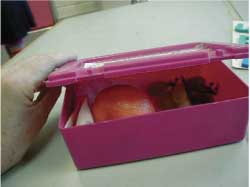
I have one orange in my lunch box. I have green grapes in my lunch box.
I got photographs from Ynez's home. We talked about them, wrote about them. I used simple sentences e.g. 'Look at Dad. I see Dad.' It was important at this stage that I used the same language as was being used at home: school clothes as opposed to uniform, etc. I linked in with the class teacher and based my reading on what was being done in the Junior Infant classroom. When the class was reading 'Hippo is in the water' we were reading 'Ynez is in the bath.' I used the same method of teaching reading as with other pupils: matching word to picture, word to word, word box, etc.
All this material was compiled in personalised book format for Ynez - 'Ynez's Book'.
Soon it became apparent that Ynez was reading well with clear pronunciation. I decided to zone in on her visual perceptual ability in order to improve and enhance her language skills. Again I quote 'reading enables children to practise sentences they cannot yet generate by themselves, improving articulation and production skills,' and 'many children can articulate words more clearly when they read them than when they spontaneously say them.' It was then I started using a digital camera in everyday situations.
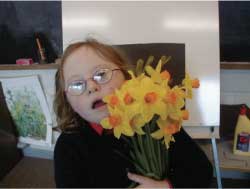
I gave flowers to Honor. 'Thank you, Ynez' said Honor. I put the flowers in water.
I based reading and language on happenings in Ynez's day in school. I photographed her schoolbag, her lunch box, her pencil case, her 'new glasses', and so on. Firstly, I would talk around the subject, e.g. my lunch box. Daily we would take out her lunch box and get her to tell me what was in it. I then photographed the box, put the image on the computer screen. Here again we would talk about it. Finally, I would print out the image and write about it.
I continued doing this every day with emphasis on Ynez talking about the pictures and then reading. Sometimes this work was planned and other times it just depended on what was going on that day. One day she brought flowers to me. The digital camera is particularly useful in situations like this. I photographed her with the flowers and immediately downloaded the image onto the computer and wrote about it. Here within minutes she was able to read about what had just happened.
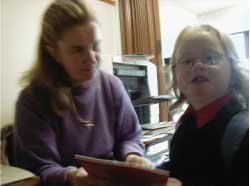
'Good Morning, Gillian'. 'Book please, Gillian'. 'Thank you, Gillian'.
I also found the camera invaluable for developing social skills. Daily we went to the School Secretary, requested a book and responded appropriately. This activity was photographed and recorded. Through reading these responses Ynez's spoken vocabulary increased from two to three words.
I continued photographing Ynez at P.E., in the playground, in the school play, singing, skipping, etc. All these images were supported with simple sentences. The most noteworthy improvement is in clarity of speech. This was very apparent as Ynez first tried to read the word 'Goofey'. After much repetition the word became perfectly clear. Ynez now had two personalised books.
In September 2002 I was wondering how to make further progress. Being back at school with new teacher, new classroom, etc. provided some material. After consultation with the Speech Therapist we decided to continue on with what I was doing with more emphasis on use of language. Again we decided to use everyday situations for reading. To this effect I gave the camera to the parents and they photographed Ynez at home: 'I brush my hair', 'I put on my clothes,' etc. We are still working on this.
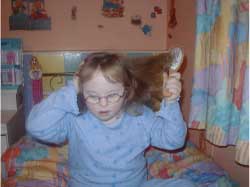
I brush my hair
I have often been asked 'Does Ynez understand what she is reading?' The answer to this is clearly 'yes'. If she has difficulty with a word she looks at the pictures for clues. When, for example, I 'mixed-up' pictures and text Ynez has successfully matched them. I have also used split sentences, and 'mixed-up' sentences, etc. I have no doubt she understands what she is reading. I also have a list of commands for Ynez to do daily: 'Take out your reading book,' 'Write your name on the whiteboard', etc. Ynez successfully carries out the appropriate task.
I find the camera very useful for linking up with home. I download the images onto a floppy or CD and send them home so that the parents can relate to what is going on in school.
One of the advantages of the digital camera is that it's use is immediate. I can take a picture and have it on the screen within seconds. I can move it around, enlarge it, delete it, put script with it, print it, etc.

I can paint
Now Ynez has progressed to writing for meaning. Since October 2002 Ynez has been writing on the computer daily. I insert a picture of Ynez at home, at school, or wherever and then Ynez writes appropriate sentences. Ynez can write up to 5 sentences unaided.
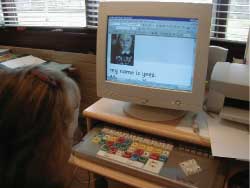
I write on the computer
There is no doubt that the reading processes as described above have brought about a marked improvement in Ynez's speech. She is now willing to use language in everyday situations. She requests items and greets people appropriately. Her expressive language is developing alongside her reading. She is reading accurately and with understanding. Reading for meaning for Ynez has been an attainable goal.
Further, teaching Ynez to read has been effective in improving both her ability to think and reason.
I'm enjoying this challenge with Ynez and will continue to develop ideas around the use of technology to improve language.
As a Resource Teacher I withdraw Ynez from the classroom and work with her for one hour daily.
Honor Mangan is a Resource Teacher for Special Needs Pupils, County Cork, Ireland

